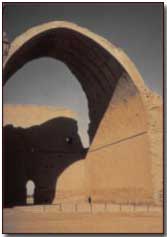Battles - The Battle of Ctesiphon, 1915
 Following an extended run of
good fortune at Basra,
Qurna,
Shaiba,
Amara,
Nasiriyeh and
Kut within the space
of a year, British forces finally ran out of luck in spectacular fashion at the
Battle of Ctesiphon, which ran from 22-25 November 1915.
Following an extended run of
good fortune at Basra,
Qurna,
Shaiba,
Amara,
Nasiriyeh and
Kut within the space
of a year, British forces finally ran out of luck in spectacular fashion at the
Battle of Ctesiphon, which ran from 22-25 November 1915.
With the occupation of Kut in November 1915 regional British Commander-in-Chief Sir John Nixon ordered Sir Charles Townshend - commander of 6th Indian (Poona) Division - to further advance upon Baghdad.
Townshend argued against further extending the tenuous British supply line - already some 600km from the sea - without first consolidating supply lines from Basra, with specific requests for supplies of extra transport and trench warfare equipment. Nixon disagreed and instructed Townshend to proceed.
In this Nixon was backed with the eager support of the Indian government - who had appointed him in the first place - and, more reluctantly, by the British government in London, whose initial opposition was overcome when the extent of India's eagerness and confidence became apparent.
The Turks meanwhile, following further defeat at Kut, had retired to carefully prepared defence positions among the ancient ruins of Ctesiphon. This formed the Turks' forward defence of Baghdad, Nixon's real aim.
 By the time Nixon gave the
order to advance to Townshend the Turks - under Nur-Ud-Din - had constructed two
lines of deep trenches either side of the
River Tigris, defended by some 18,000 largely experienced troops.
By the time Nixon gave the
order to advance to Townshend the Turks - under Nur-Ud-Din - had constructed two
lines of deep trenches either side of the
River Tigris, defended by some 18,000 largely experienced troops.
Facing them Townshend brought approximately 11,000 Anglo-Indian troops, a force unlikely to be further boosted save for two Indian divisions promised from the Western Front for the purpose of occupying Baghdad.
The reality was that the British government were willing to be convinced of the possibility of a major victory on the Mesopotamian Front. While the capture of Baghdad had no great strategic value in its own right, it would nevertheless undoubtedly prove of great propaganda value, being one of the four great cities of Islam: a matter of some importance in the light of continuing failure at Gallipoli.
Thus Townshend's force, aided by Firefly (a newly-arrived monitor) plus a shallow-draft gunboat, initiated operations against Nur-Ud-Din on 22 November 1915. Aware of the impracticality of launching a dual attack on both sides of the river at once - not only due to shortage of men but also on account of poor ground conditions on one side - he decided to concentrate his attack on the east bank.
Specifically he chose to repeat his earlier success at Kut-al-Amara and issued orders for night-marching, his aim being to surprise the Turk defenders in a flank attack.
 Unfortunately
many of his force got lost in the dark, thus losing all element of surprise,
and the British attack foundered while negotiating the Turkish second-line
defences.
Unfortunately
many of his force got lost in the dark, thus losing all element of surprise,
and the British attack foundered while negotiating the Turkish second-line
defences.
Townshend, unlike earlier encounters, was unable to call upon naval support given the Turks' extensive deployment of mines and artillery.
The following day, 23 November, Turkish forces launched a mild counter-attack intended at reclaiming their front-line positions; although it failed Townshend's casualty rate was increasing at an alarming rate.
The British had suffered some 40% casualties, at around 4,500; and while Nur-Ud-Din had suffered more than twice that figure, at 9,600, he could readily call upon reserves from nearby Baghdad (a mere 25km away), a luxury not afforded to Townshend.
Even so Nur-Ud-Din ordered a general withdrawal upon hearing of impending British reserve forces; this did not last however and the Turkish retreat was halted once the latter realised their mistake. Informed of the change in Turkish tactics by his sole reconnaissance aircraft Townshend himself authorised a British retreat.
 Harried ceaselessly by both the
Turks and marsh Arabs (hostile to Turk and Briton alike) Townshend's beleaguered
force eventually wound its way back to Kut on 3 December, preceded by make-shift
hospital craft operating in highly unsanitary conditions. Townshend also
lost his warships during the retreat, sunk by Turkish shore batteries.
Harried ceaselessly by both the
Turks and marsh Arabs (hostile to Turk and Briton alike) Townshend's beleaguered
force eventually wound its way back to Kut on 3 December, preceded by make-shift
hospital craft operating in highly unsanitary conditions. Townshend also
lost his warships during the retreat, sunk by Turkish shore batteries.
Once at Kut Townshend launched preparations for its defence, pending reinforcements from Basra. Shocked by the belated resilience of Ctesiphon's Turk defenders both British and Indian governments resolved to despatch reinforcements to Mesopotamia to provide assistance to Townshend, the former giving serious consideration to regarding both Mesopotamian and Palestine Fronts as a whole.
Click here to view a map charting operations in Mesopotamia through to 1917.
Photographs courtesy of Photos of the Great War website
Observation balloons were referred to as 'sausages'.
- Did you know?
